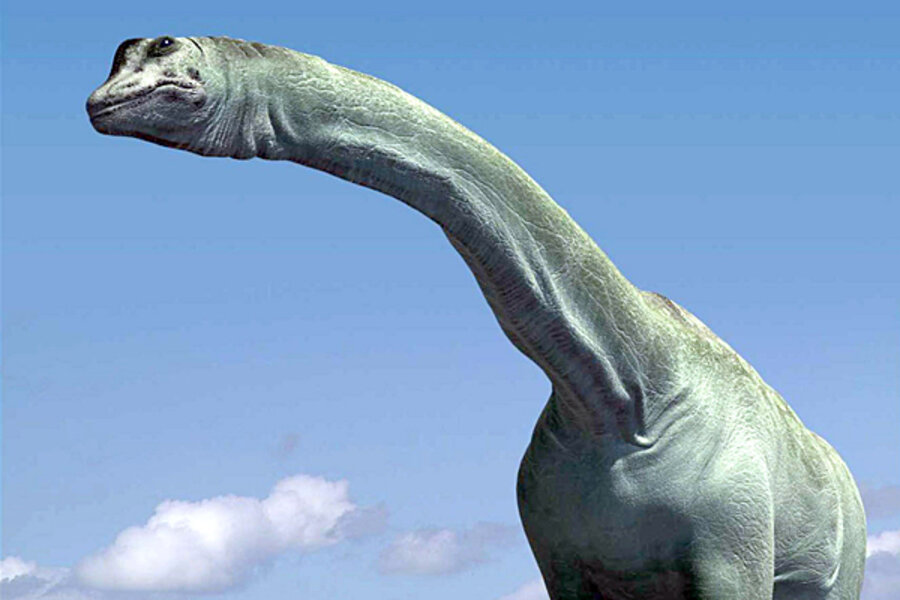Did dinosaur 'emissions' help warm the prehistoric climate?
Loading...
Worried about about global warming and the methane that cattle burp into the air? Be glad Brontosaurus is extinct.
Sauropods – giant, long-necked, prehistoric vegans that roamed the planet for more than 100 million years through the end of the age of dinosaurs – released nearly as much methane into the atmosphere each year as do all natural and industrial sources today, according to an estimate from scientists in Britain.
The team, led by Liverpool John Moores University biologist David Wilkinson, suggests that methane emissions from sauropods could have played a key role in sustaining a climate already warmed by carbon-dioxide concentrations some 2 to 6 times higher than today.
It was a world in which the poles were ice-free and crocodile-like creatures thrived in the Arctic. Scientists have pinned the high levels of carbon dioxide on widespread volcanic activity as plate tectonics rearranged continents.
CO2 and methane are both greenhouse-gases, with CO2 staying in the atmosphere far longer than methane. But while a newly minted methane molecule will remain airborne for only about 10 years, molecule for molecule, it is a far more potent greenhouse gas.
Back in the day, the warm wet climate and an atmosphere rich in CO2 would have turned much of the available land area into enormous smorgasbords, brimming with a wide variety of leafy treetops and fulsome shrubs – all within reach of the animals' long necks.
Estimating methane emissions “for animals that are unlike anything living has to be a bit of an educated guess,” Dr. Wilkinson cautions in a prepared statement. The fossil record has allowed researchers to infer a great deal about the physiology and biology of sauropods. But estimates of their ranges and the number that could inhabit the same square mile of land require a lot of assumptions.
Still, the estimate “makes a lot of sense,” says Felisa Smith, a biologist at the University of New Mexico in Albuquerque. Dr. Smith and colleagues published an estimate two years ago of the possible climate effect from methane lost to the atmosphere as large plant-eating mammals roaming North and South America went extinct. Smith and others point to the large-scale arrival of humans from Eurasia around 14,300 years ago as the extinction's main cause.
The connection between natural sources of methane – from the stomachs of cows and other ruminants to termites to swamp mud – already get factored in to modern greenhouse-gas calculations. Still, while Brontosaurus burps or emissions via other, more-egregious, violations of good manners trigger giggles, such calculations also suggest “that the feedback between animals and climate is a little tighter than we tend to think it is today,” Dr. Smith says.
For Dr. Wilkinson and colleagues, it's all about the microbes in a ruminant's digestive tract.
The bacteria would have had a lot to process. Sauropods still hold the record for largest land animals in the planet' s 4.6 billion-year history. From nose to tail tip, they ranged in length from 20 feet to 112 feet. One member of the group, Amphicoelias fragillimus, is thought to have spanned 190 feet and weighed up to 135 tons.
Based on the fossil record, many of these creatures sported teeth better suited for stripping vegetation than for long sessions of contemplative chewing. No “stomachs” in these animals. Researchers speak instead of fermentation chambers.
For their estimate, Wilkinson and colleagues settled on 10 22-ton sauropods to every 250 acres of land. Increased warmth, moisture, and CO2 levels would have sustained far more vegetation than does today's climate. Given the behemoths' appetites, the team estimated that all the sauropods on the planet would have produced a combined 520 million tons of methane a year, compared with between 50 million and 100 million tons for today's ruminants.
Even if sauropod emissions only amounted to 260 million tons a year, the methane still would have had a significant climate effect, according to the team.
The work represents a “proof of concept,” Wilkinson and colleagues write in the paper detailing their results in Tuesday's issue of the journal Current Biology.
But it resonates with Smith. In 2010, she and colleagues from the Los Alamos National Laboratory and the Smithsonian Institution's National Museum of Natural History calculated that the relatively sudden die-off in large-bodied plant eaters – mastodons, giant sloths, and other large animals – within about 1,000 years of humans' large-scale arrival in the Western Hemisphere corresponded with a decline in atmospheric methane.
This decline came at the beginning of a cool period that lasted a little more than 1,000 years – called the Younger Dryas. Smith's team estimated that the loss of large plant eaters in North and South America could have accounted for at least 12.5 percent of the methane decline, and perhaps all of it.







